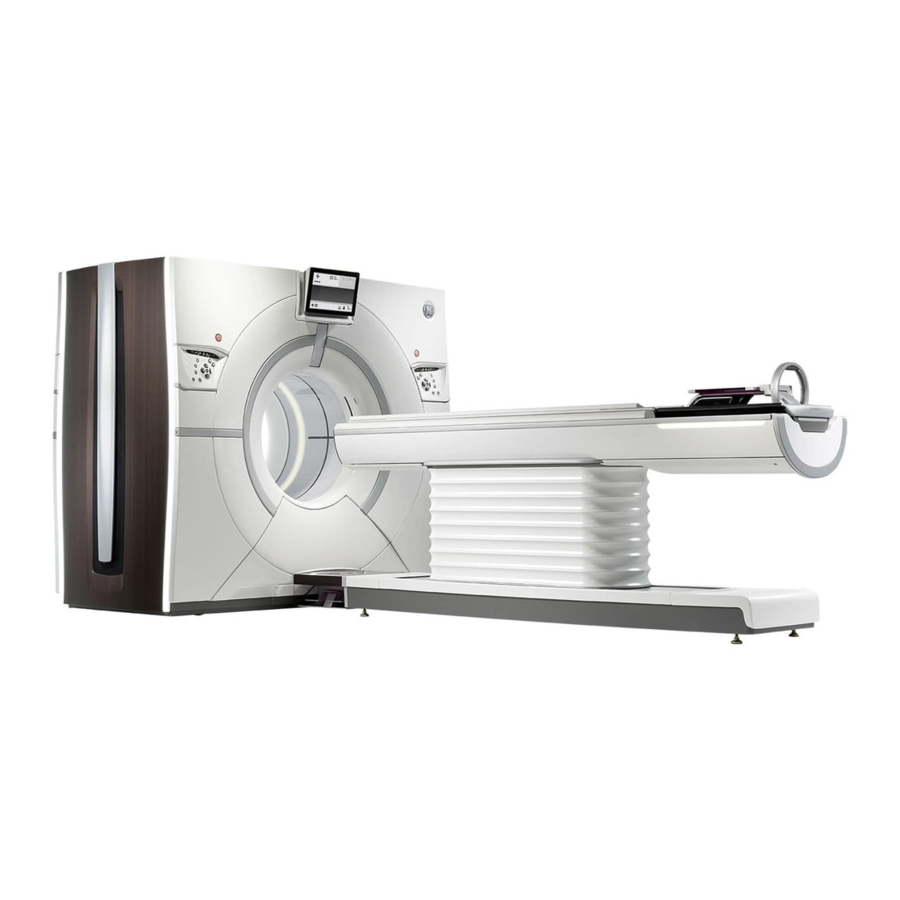
GE Revolution CT Manuals
Manuals and User Guides for GE Revolution CT. We have 1 GE Revolution CT manual available for free PDF download: User Manual
GE Revolution CT User Manual (702 pages)
Tomography Scanner
Brand: GE
|
Category: Medical Equipment
|
Size: 16.29 MB
Table of Contents
-
-
Fire Safety69
-
Laser Safety77
-
Data Safety81
-
-
Scan Monitor100
-
New Patient100
-
Patient Schedule101
-
Scan Setup102
-
-
Image Monitor108
-
-
Cancel116
-
Pop-Up Windows117
-
Mouse Controls117
-
-
Overview121
-
-
-
-
-
Overview133
-
Large Patients134
-
-
High Kv135
-
Ma Adjustment135
-
Scan Type135
-
-
-
Overview137
-
-
-
Overview157
-
Scanner Desktop158
-
Gantry165
-
Table178
-
-
Cradle Pad180
-
Pole181
-
-
Components183
-
Coverage183
-
Axial Interval183
-
-
System Cabinet186
-
-
-
Overview191
-
-
Log On/Log off192
-
Logon Window192
-
Log off194
-
Log on194
-
-
-
Considerations196
-
Shutdown Process196
-
Restart Process197
-
-
-
Tube Warmup198
-
Calibration198
-
Tube Warmup199
-
-
-
-
Overview203
-
Patient Schedule204
-
HIS/RIS Search211
-
-
Chapter 11 SCAN
217-
Overview217
-
Scan Theory218
-
CT Perfusion220
-
Total Scan Time226
-
-
How AEC Works227
-
When to Use AEC228
-
Summary229
-
AEC Messaging230
-
Smartma/Odm232
-
Smartma232
-
Smartma Theory233
-
References234
-
Smartma Faqs234
-
Smartma239
-
-
Kv Assist241
-
Kv Assist Theory242
-
Image Display243
-
Kv Assist Faqs243
-
References244
-
Exam Workflow245
-
-
Using Contrast245
-
Using Protocols245
-
-
Acquire a Scout256
-
Start a Scan262
-
Close the Exam264
-
Stop a Scan264
-
-
Scan Parameters265
-
Scan Type265
-
Axial265
-
Cardiac Axial265
-
Cine265
-
Helical265
-
Hi Res Mode265
-
Rotation Time266
-
-
-
Kv Mode270
-
Manual Kv Mode270
-
Ma Mode271
-
Manual Ma Mode272
-
Smartma Mode272
-
ODM Mode273
-
Noise Index275
-
-
-
Set the Ma281
-
Set the Kv282
-
-
Recon Parameters289
-
Auto Voice301
-
-
-
Add a Group303
-
Delete a Group303
-
-
-
Prerequisites305
-
Dose Information306
-
-
-
-
-
Overview331
-
Cardiac Workflow332
-
-
Consent Forms332
-
-
-
Scan Type345
-
Primary Recon345
-
Secondary Recon345
-
-
Auto Gating348
-
Gating Based on349
-
Adaptive Gating351
-
Coverage Speed353
-
Number of Passes353
-
-
-
Auto Gating356
-
Cardiac Recon362
-
Cardiac QC Recon362
-
Primary Recon362
-
-
Method 1365
-
Method 1 and 2365
-
Method 2365
-
-
-
Snapshot Freeze367
-
-
-
Overview371
-
Image Display374
-
-
Auto-View382
-
-
Image Tools386
-
Display Normal386
-
-
Considerations387
-
Applying Filters388
-
-
Apply a Matte392
-
Adjust the W/L392
-
Function Keys393
-
Mouse393
-
-
-
Measurements394
-
User Preferences406
-
-
-
Overview411
-
Add/Subtract412
-
-
-
Icons421
-
Batch Options424
-
Output Options425
-
Transfer Options426
-
-
-
Exam Split434
-
-
-
Overview441
-
User Profile441
-
Considerations442
-
Reformat443
-
Display448
-
Annotation448
-
Roi449
-
Display Tab453
-
My Tools Tab455
-
View Tools455
-
Add a Tool456
-
Remove a Tool456
-
-
Measure460
-
Measure Distance460
-
Measure Angle461
-
Measure Area461
-
Measure Volume461
-
-
Manage Colormaps461
-
Add an ROI462
-
-
View Types464
-
Volume Render467
-
Render Modes468
-
Cut Planes476
-
Work with Colors477
-
Add Colors477
-
Change a Color478
-
-
Autofit478
-
Zoom In/Out481
-
Segment482
-
Batch Film492
-
Batch Types492
-
Batch Protocol492
-
Film/Save Tab493
-
Batch Screen493
-
-
-
-
Overview503
-
File Manager504
-
Controls Area505
-
Search Box506
-
Source Menu507
-
Recycle bin508
-
Exam List509
-
Deleting Exams513
-
PPS Column515
-
Series List515
-
-
Archive/Network522
-
Workarounds530
-
-
Media Creator532
-
Save Images535
-
Restore Images538
-
-
Data Export543
-
Compose Tab543
-
Export Tab547
-
Compose a Report552
-
Export a Report552
-
Delete Items554
-
-
Patient Data555
-
Recon Management565
-
-
-
Auto-View571
-
Expanded Mode571
-
Series Binding571
-
-
Data Transfer573
-
-
-
Overview575
-
Protocols576
-
Build Protocols576
-
Use Protocols576
-
Edit Protocols577
-
View Protocols577
-
System Options577
-
-
Protocol Numbers578
-
Edit a Protocol579
-
Series Numbering582
-
-
-
-
Overview593
-
Access Controls594
-
Introduction594
-
Users and Groups594
-
Open EA3595
-
Add a Local User597
-
-
Remove a Group604
-
Remove a User604
-
-
-
-
-
Overview613
-
System Tools614
-
-
Introduction617
-
-
-
-
Introduction635
-
Emergency Stop635
-
CT Description635
-
-
X-Ray Source636
-
CT Detector636
-
Gantry637
-
Table637
-
System Cabinet637
-
Scanner Desktop637
-
-
Network641
-
-
Overview648
-
Scout648
-
Axial648
-
Cine648
-
Helical649
-
Cardiac Axial649
-
ECG-Modulated Ma650
-
Smarttrack651
-
-
Image Display653
-
CT Number653
-
Pixels654
-
RAS Coordinates655
-
Window Width658
-
Window Level658
-
-
-
-
Abbreviations675
-
-
-
Units of Measure677
-
Advertisement
Advertisement
